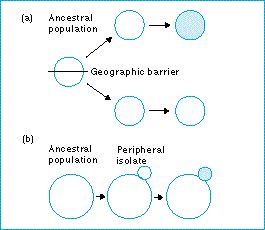Peripheral isolation

Peripheral isolation speciation, also known as peripatric speciation, is a form of allopatric speciation.
In peripatric speciation a small population, at the extreme edge of the species' range, is separated off. The same sequence of divergence and possible meeting of the two populations could then take place as in speciation by subdivision.
It has been argued that peripatric speciation has been much commoner than standard allopatric speciation. There are two reasons for this:
• It may be physically more probable that a small population would be isolated at the edge of a species range than that a barrier would divide the whole of a species range.
• It is thought to be particularly common for isolated populations at the edge of a species range to be distinct in form, whereas the individuals in the main part of the species range show less variation. Distinct peripheral isolates have often been observed on islands.
For example, the kingfishers on the peripheral islands have diverged more than would be predicted from the degree of variation on New Guinea. This phenomenon has two possible explanations:
1. Local adaptation: the conditions on the island may be such that natural selection favors a distinct phenotype there.
2. Isolation: gene flow from the rest of the species may be reduced on the island, allowing the population there to diverge.
Whatever its explanation, if peripherally isolated populations are likely to diverge from the form of their ancestors, they may well be a common stage on the way to speciation.
The peripheral isolation model of speciation is the one favored by the theory of punctuated equilibrium.
Figure: two models of allopatric speciation. (a) The dumb-bell model in which the ancestral species is divided into two roughly equal halves, each of which forms a new species. (b) The peripheral isolate model, in which the new species forms from a population isolated at the edge of the ancestral species range.
| Next |



